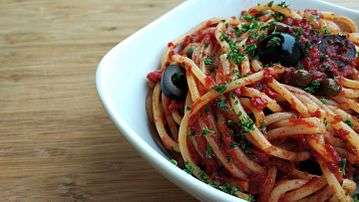Spaghetti alla puttanesca
 A plate of spaghetti alla puttanesca | |
| Alternative names | pasta alla puttanesca, pasta puttanesca |
|---|---|
| Course | Main |
| Place of origin | Italy |
| Region or state | Campania |
| Creator | Sandro Petti (some dispute this) |
| Invented | mid 20th century |
| Serving temperature | Hot |
| Main ingredients | Spaghetti, tomatoes, olives, capers, garlic, and anchovies (in Lazio). |
| Variations | spaghetti alla puttanesca with tuna |
|
| |
Spaghetti alla puttanesca (pronounced [spaˈɡetti alla puttaˈneska]; literally "spaghetti in the style of a prostitute" in Italian) is an Italian pasta dish invented in the mid-20th century.
The ingredients are typical of Italian cuisine: tomatoes, olive oil, anchovies, olives, capers and garlic.[1]
Origin
Various accounts exist as to when and how the dish originated, but it likely dates to the mid-twentieth century. The earliest known mention of it is in Raffaele La Capria’s Ferito a Morte (Mortal Wound), a 1961 Italian novel which mentions "spaghetti alla puttanesca come li fanno a Siracusa (spaghetti alla puttanesca as they make it in Syracuse)".[2] The sauce became popular in the 1960s, according to the Professional Union of Italian Pasta Makers.[3]
The 1971 edition of the Cucchiaio d’argento (The Silver Spoon), one of Italy's most prominent cookbooks, has no recipe with this name, but two which are similar: The Neapolitan spaghetti alla partenopea, is made with anchovies and generous quantities of oregano; while spaghetti alla siciliana is distinguished by the addition of green peppers. Still again there is a Sicilian style popular around Palermo that includes olives, anchovies and raisins.[4]
In a 2005 article from Il Golfo—a daily newspaper serving the Italian islands of Ischia and Procida—Annarita Cuomo asserted that sugo alla puttanesca was invented in the 1950s by Sandro Petti, co-owner of Rancio Fellone, a famous Ischian restaurant and nightspot.[5] According to Cuomo, Petti's moment of inspiration came when—near closing one evening—Petti found a group of customers sitting at one of his tables. He was low on ingredients and so told them he didn't have enough to make them a meal. They complained that it was late and they were hungry. "Facci una puttanata qualsiasi," or "Make any kind of garbage," they insisted.a[›] Petti had nothing more than four tomatoes, two olives and some capers—the basic ingredients for the sugo, “So I used them to make the sauce for the spaghetti,” Petti told Cuomo. Later, Petti included this dish on his menu as spaghetti alla puttanesca.
Basic recipe
The sauce alone is called sugo alla puttanesca in Italian. Recipes may differ according to preferences; for instance the Neapolitan version is prepared without anchovies, unlike the version popular in Lazio, and chili peppers are sometimes added. In most cases, however, the sugo is a little salty (from the capers, olives, and anchovies) and quite fragrant (from the garlic). Traditionally, the sauce is served with spaghetti, although it also goes well with penne, bucatini, linguine and vermicelli.
Chopped garlic and anchovies (omitted in the Neapolitan version) are sautéed in olive oil. Chopped chili peppers, olives, capers, diced tomatoes and oregano are added along with salt and black pepper to taste. The cook then reduces this mixture by simmering and pours it over spaghetti cooked al dente. The final touch is a topping of parsley.[6]
In popular culture
The dish is featured in The Bad Beginning from the novel series A Series of Unfortunate Events by Lemony Snicket as the dish the Baudelaire children prepare at Count Olaf's house. The dish also features prominently in the movie based on the novels. The dish is also featured in the opening scene of season 11, episode 10 of the TV series Bones. This dish also appears in Part 4 of JoJo's Bizarre Adventure, Diamond Is Unbreakable, in the story arc "Let's Go Out for Italian Food", where the Stand user Tonio Trussardi plants his Stand, Pearl Jam, into the food he makes in order to rid of his customer's health problems. It is also featured in 'Sex and the City" Season 4, Episode 17, A 'Vogue' Idea. Charlotte wants to throw Miranda a traditional baby shower with a lovely 'puttanesca'. Miranda instead insists on a bucket of chicken.
See also
Notes
^ a: In this usage, puttanata is an Italian noun meaning something worthless. It derives from the Italian word for whore, puttana.
References
- ↑ Zanini De Vita & Fant 2013, p. 68.
- ↑ The dictionary entry is cited in Jeremy Parzen, ‘The origins of Sugo alla puttanesca?’, Do Bianchi, 13 January 2008, an article which supplied a number of the sources used here.
- ↑ ‘Sughi d’Italia: 1000 anni di pasta, 1000 anni di condimenti’, Unione Industriali Pastai Italiani
- ↑ Il nuovissimo cucchiaio d’argento, ed. by Antonia Monti Tedeschi, 6th edn (Editoriale Domus, 1971), pp. 220–221
- ↑ Annarita Cuomo (17 February 2005). ‘Il sugo “alla puttanesca” nacque per caso ad Ischia, dall'estro culinario di Sandro Petti’. Il Golfo. Archived from the original on 13 August 2014
- ↑ Recipe on the site for the Accademia Italiana della Cucina
- Zanini De Vita, Oretta; Fant, Maureen B. (2013). Sauces & Shapes: Pasta the Italian Way. New York: W. W. Norton & Company. ISBN 978-0-393-08243-2.
